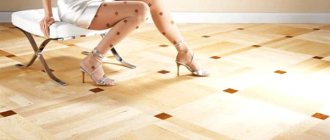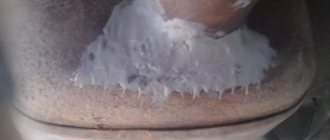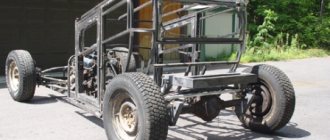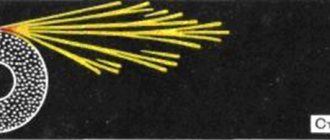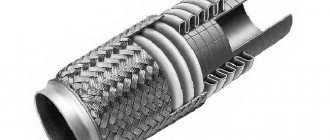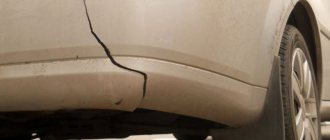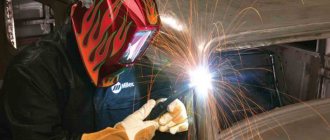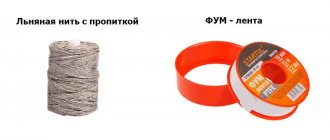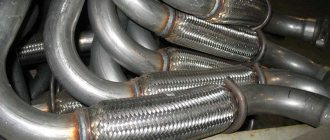If you decide to start painting your vehicle, it is likely that you will be faced with through holes in the body that have arisen as a result of exposure to rust. It is worth noting that body repairs are quite expensive, so not every car enthusiast wants to turn to professionals.
As a result, many are interested in how to repair holes in a car body without welding with their own hands. This is exactly what we will talk about now.
How to repair through holes on a car body using putty without welding
Before repairing a hole in the car body, you should prepare:
- fiberglass and automotive putty;
- aluminum mesh;
- putty knife;
- sandpaper (if possible, it’s also worth looking for a sanding machine);
- primer, paint, varnish.
Fixing holes in a car body itself is distinguished by its simplicity. First of all, you should remove the rust using an angle grinder or any other suitable equipment. Next, we cut out the patch from aluminum, and then attach it to the body using masking tape. We apply a thin layer of fiberglass putty (here it is important not to touch the tape, because then you will have to remove it). When the putty sticks, peel off the tape and putty the remaining areas.
It is important that the layer is as thin as possible, without tubercles or other irregularities.
When everything is dry, sand everything using coarse sandpaper or a sander.
Having achieved a flat and smooth surface, apply a second ball of putty - automotive putty. We wait until it dries and level it again. Then the surface is primed (do not forget to cover the areas that do not require painting with film). When the primer is finished, you can paint the body.
It is worth noting that the patch will be more stable if you apply a couple of layers of putty on the back side. In addition, it is also possible to seal holes in the car body without welding using putty and without using a patch. In this case, it is necessary to apply a lining on the back side so that the composition is well fixed. On the other hand, this solution is only suitable for very small through holes.
Let's watch a detailed video on how to seal holes without welding:
Final stage
Regardless of how the car body was repaired, they all end with putty. However, it absorbs moisture, which leads to rapid destruction. Therefore, it must be coated on top with an anti-corrosion or epoxy primer. Body repairs are completed without welding by painting. To do this, use a spray gun or aerosol cans, after covering the adjacent surface of the car with plastic film. You should not use a brush, as drips are possible.
The proposed methods will help to repair a car without welding in case of single damage. However, if a large area is affected by corrosion, it will be easier and more reliable to contact a car repair shop to replace the rusted area by welding. Most often this happens to the floor, so it is recommended to regularly check it from underneath the car using an inspection hole or lift.
Using a soldering iron
There is another way to repair a hole in a car body without welding. A soldering iron is required here. First of all, we clean the area from rust. We make the patch from a sheet of metal (you don’t need to worry too much about this; an ordinary can of auto chemicals will do).
It is important that the patch is slightly larger than the holes and also completely covers them.
Additionally, you can coat the metal surface with anti-corrosion compounds - this will increase the quality of our repairs. Then we service the edges of the patch, after which, using a fairly powerful soldering iron, we solder it with a continuous seam.
Next, you should check whether it turns out that the patch protrudes somewhat above the body. If there is a protrusion, we eliminate this deformation with several gentle blows of the hammer. We remove various dents with putty (it is important that its layer reaches no more than 2-3 mm, otherwise the material will crack). Before filling, clean the surface with a metal brush.
In order for the putty to adhere well, it is important that abrasive marks (small scratches) appear on the patch.
The next step is primer. Here it is necessary to complete everything as quickly as possible to avoid the possibility of rust occurring in the future. It is best to first apply a thin layer of phosphate primer, and when it dries, another two or three layers of acrylic two-component composition (the interval between applications should be about 5-10 minutes). Everything dries in about 3-4 hours; if there is infrared heating, you can reduce the procedure to 20 minutes.
All methods of dealing with body rust
Before you start working with metal, you need to detect corrosion. For work, it is better to choose a warm day to wash and dry the car.
When you identify areas affected by rust, study the depth of its penetration and then try to choose one of the existing methods for eliminating it.
1. Working with a sandblasting machine allows cleaning to penetrate into all pores of the metal.
The surface remains the same both in thickness and structure. The smallest particles of sand actively bombard corrosion.
Rust is pressed through by grains of sand and washed away by them.
2. Grinding using a machine. The rust coating is destroyed, simply cleaned to bare metal, this method is as fast and effective as possible.
The only disadvantage that cannot be avoided during corrosion is that the thickness of the metal being processed decreases.
3. Sanding by hand is carried out using a metal brush or sandpaper, moving it along the working surface.
Scotch Brites and abrasive discs are also used with this method. This method can be considered the cheapest, and you will always reach difficult places.
This method also takes into account the fact that the thickness of the metal will also suffer.
Preparing to fill a hole in a car body
So, you have discovered a through hole in the body of your car. do not rush to turn to expensive craftsmen who guarantee the high quality of their work with a guarantee that rust will not appear in this place for many years. If you are limited in funds, such treatment will lead you into debt and taking out loans. An alternative to this development of the situation may be to repair the hole in the car body yourself.
First, you need to prepare to seal the hole in the car body. To do this, you need to go to the nearest car market or auto parts store. We will need materials for working with paintwork and metal car body panels:
- fiberglass and epoxy glue;
- high power soldering iron;
- a hammer with a wooden striker or a hammer and a wooden spacer;
— acid rust converter;
— putty, automotive enamel;
— two-component acrylic primer;
— two-component acid (phosphate) primer.
Next, the place on the car body is prepared where a through hole has appeared due to natural corrosion. It is necessary to thoroughly clean the surface at a distance of several centimeters around the hole in the body panel using sandpaper. We must remove a layer of varnish, paint, possible putty and sand off any traces of rust. The surface around the hole should be thoroughly treated with an anti-corrosion solution.
Why does corrosion occur?
The destruction of metal occurs from exposure to unfavorable environmental factors.
Corrosion is a broader concept than rust, which most likely can be attributed to its variety. It arises not only from exposure to water, but also to the chemicals that are present in it.
In this regard, the bottom of the car and its body most often suffer from corrosion.
Corrosion can be dry or wet . If car parts are in a dry environment, such as a garage, and still become dull, they need anti-corrosion treatment.
Dry corrosion is not so destructive to the body. But wet corrosion is much worse; the metal becomes covered with a layer of rust and grows regularly.
If the process has just begun, it is necessary to fight it while it is in its infancy, because further it will be much more difficult.
If you park your car in a heated garage simply from the cold air in the winter, in this case the risk of metal destruction increases in case of poor exhaust in the garage.
A sharp temperature change contributes to the appearance of condensation on the metal, and rust begins to have a destructive effect.
Rust most often forms in those who do not clean the bottom during the cold season. This procedure gives only a short-term effect, but the car needs regular care.
After another trip outside your garage, you need to clean the bottom of sand and water again. Constant prevention reduces the risk of corrosion.
Do not delude yourself that only in the cold season the paintwork suffers.
It is worth noting that in warm weather, particles of asphalt and sand fly into it, in this case it is also necessary to take measures, then you will not have to think about which method to choose to remove rust.
Fiberglass and epoxy patch application
The algorithm for sealing a hole in a car body using fiberglass and epoxy glue is quite simple.
- We clean the area of the body panel surface around the hole. Be sure to treat the cleaned surface with a rust converter.
- We cut out at least three fiberglass patches that are at least 20-30 millimeters larger than the size of the hole in the body on all sides. In this case, the first patch is larger by 20-30 mm, the second patch is larger by 30-40 mm, and the third patch is larger by 50-60 mm.
- It is necessary to saturate each patch with epoxy glue, which will not only glue them together, but will also prevent moisture from seeping in from the outside. This will also allow you to avoid future bubbles under the paint in this area of the patch, which arise due to the hygroscopicity of the material. Epoxy glue eliminates hygroscopicity.
- The hole is sealed on the back side of the body panel - from the inside of the body. Layers of fiberglass in epoxy glue are glued alternately. In this case, you should wait until the bottom layer of the patch dries before gluing the top layer.
- Next, the surface of the exposed part of the fiberglass is cleaned from the outside of the body panel. After this, a layer of putty is applied, and then the entire body panel is rubbed and painted with varnish.
Places where rust appears most
Negligence leads to the emergence of more and more outbreaks. However, no matter what efforts the motorist makes, corrosion can appear on the fenders, bottom, and sills of the car.
Corrosion does not often appear on the inside and outside of the hood and trunk. But even these areas can be affected if the car is left outdoors during the cold season, during rain or under snow.
Parts that come into contact with the overlay elements are the most unprotected areas that can be affected by rust.
The areas of the floor that are least frequently cleaned are those under the seats and the driver’s feet. If minor signs of corrosion are visible in these areas, they must be removed.
You must always remind yourself that even dry corrosion, due to indifference and wasted time, develops into through corrosion.
Take action immediately to prevent things from developing into serious problems.
How to remove “saffron milk caps” and “bugs”
Many people want to believe that if rust has just appeared and the lesions are small, then they can be eliminated with some miracle remedy. Unfortunately, this is impossible in principle. The rust that appears on the surface of the paintwork is like the tip of an iceberg; the main damage is deep inside.
There are products on sale that will help remove the red color from the body. For example, there is Anti-Rust paste - it removes red spots quite quickly and well. This is the same rust converter that we discussed above. It eliminates the visible signs, but not the source itself. Such manipulations usually last for 2–6 weeks (depending on weather conditions), and they are most often used immediately before selling the car.
Small “bugs” sometimes cause big problems for the car seller!
If you want to get rid of the problem in the long term, then you cannot do without physical intervention. It is necessary to stop the access of air and moisture directly to the metal. Theoretically, you can prolong the effect of the paste if, after treatment, you cover the damaged area of the body with clear varnish. But it will work if the converter has managed to remove all the rust. In most cases, this does not happen, since the depth of penetration of the product is small.
Unfortunately, it will not be possible to hide damage for a long time only with the help of paste.
Rivets
This method not only repairs large holes in the car body, but also replaces parts (fenders, aprons) without welding. In terms of reliability, it is not inferior to welding. It is recommended to install rivets in an inconspicuous place. Since there is no splash of molten metal during operation, like welding, it is often used to repair car floors.
The riveter required for the job can be bought in a store (costs approximately 500 rubles). The technology is simple:
- The patch is cut so that it overlaps 2 cm around the edges of the hole.
- By attaching it to the body, it is given the desired shape.
- The locations of the holes for the rivets are marked.
- After drilling the patch with a drill according to the diameter of the rivets (4 - 6 mm), it is advisable to countersink the edges of the holes so that it fits more tightly to the surface of the car body.
- Having applied the patch again, the center of the first hole is marked and drilled.
- After riveting it and leveling it, the patches are tapped and the remaining holes are drilled in place.
- To ensure a tight fit of the patch to the car body, rivets are fastened from the center to the edges.
- To prevent moisture from getting inside, the joint around the perimeter and rivets is coated with sealant.
How to delete: options
We have become acquainted with the causes and places, let's move on to methods of correct elimination. There are two methods that differ in the way they remove rust:
- Mechanical - cleaning, priming, puttying, painting.
- Chemical - rust converters or kits for galvanizing metal.
You cannot do without the first method if the rust is strongly ingrained into the metal. Then it is necessary to completely eliminate traces of corrosion until pure iron (ideally shiny) remains. To do this, you may need additional tools and resources, which we will discuss below in step-by-step instructions. The second option is suitable for hard-to-reach places. These could be curves on the bottom of the car or the inside of the arches, which are difficult to process using mechanical means. Depending on the product, rust after chemical treatment can turn into foam (you need to rinse with water and dry the surface) or harden and become covered with a protective layer suitable for painting. Be sure to read the instructions and recommendations for the use of chemicals before purchasing. Before starting work, try to assess the extent of damage to the body and assess whether you can etch the damage with chemicals alone. For a positive result, it is necessary that “live” iron remains after the initial cleaning. If there are through holes or the final thickness of the metal after processing is too small, then more serious body repairs will be needed, that is, initially all these areas will need to be repaired using welding or putty with fiberglass.
Gel
Another option for the release form of corrosion converters is gel.
Permatex
This corrosion converter comes in a gel form. It can be easily applied to rusty areas using a spatula. The gel will instantly form a layer of protection. Permatex does not run down and is effective within a couple of minutes after the start of application. In case of a significant layer of rust, another treatment with the drug will be required after half an hour.
Advantages:
- No rinsing required.
- Protects the surface from relapse for a long time.
- Effectively removes any rust.
- Works like a real primer.
- Easy to apply, does not bubble or flow.
Minuses:
- High price.
KerryGel formula KR-240
The main active ingredient of the product is phosphoric acid. It is supplemented with a special structure modifier. The latter destroys the crystalline rust lattice to allow the active substance to penetrate directly into the rust. After the processing process, the metal is coated with a zinc-iron phosphate film. It reliably protects the surface from the reappearance of rust.
Advantages:
- Creates the effect of cold galvanizing.
- Penetrates rust quite deeply.
Minuses:
- Without repeated treatment, it has little resistance to relapse.
- The product must be washed off.
B-52 Vershina
Gel B-52 Vershina has a viscous consistency, which is convenient when applied to vertical metal sheets. The composition does not drip and does not leave puddles or streaks. The reaction with rust is very strong, since the formula of this product includes a mixture of aggressive salts and mineral acids.
Advantages:
- Affordable price.
- Convenient to use.
Minuses:
- Does not convert rust into soil.
- Does not form protective layers on the surface.


